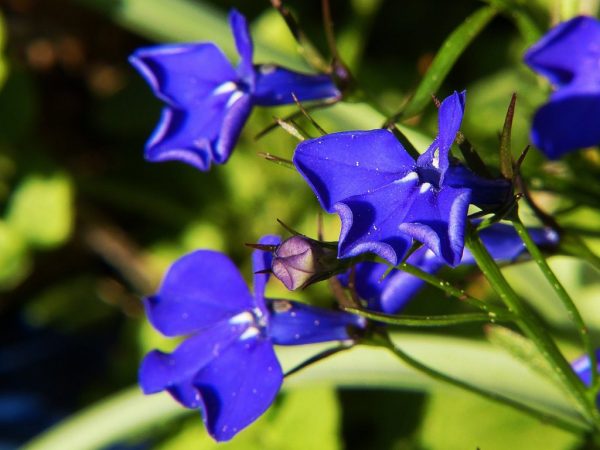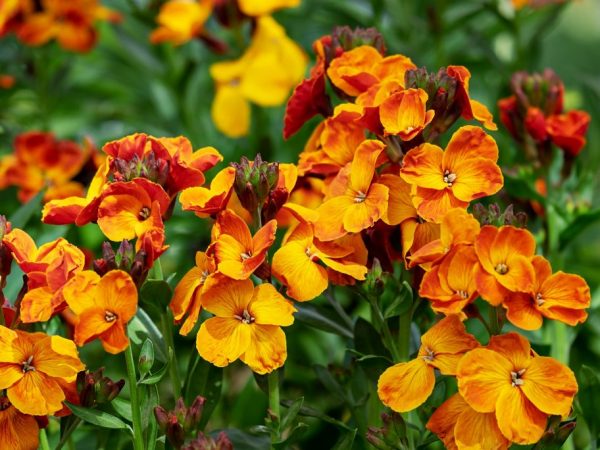Sowing rules for lobelia seedlings in 2019
Lobelia is an adorable border flower of the bellflower family. Its homeland is South Africa, where it grows like a perennial, and in the temperate climate of the middle zone of lobelia, it is an annual crop. Looking to grow a gorgeous flower ball from seeds? Then study the rules, subject to which sowing lobelia seedlings in 2019 will be successful.

Sowing rules for lobelia seedlings in 2019
Sowing seedlings
Before you start growing lobelia, you need to choose the right planting material and clearly determine the sowing date, because 2.5-3 months pass between the planting of seeds and the appearance of the first flowers.
If you have a heated greenhouse with the right lighting, you can sow it in January-February. A prerequisite is the ability to provide additional lighting. If this is not possible, seeds are sown in March. With proper care, they will quickly catch up with previously planted plants in terms of development and flowering time.
Timing
Seeds for seedlings are sown in February-March. Some growers start doing this in January. The lunar calendar will help you choose the right sowing time in 2019.
Auspicious days for annual flowers:
- January - 17-19, 23-27;
- February - 6-8, 11-17, 21-25;
- March - 12-17, 19-20;
- April - 6-8, 11-13, 15-17; 29-30;
- May - 8-17, 21-23, 26-28;
- June - 1, 2, 5, 6, 9-13, 16-20;
- July - 8-10.
Suitable days for sowing perennials:
- January - 14-19, 23-27;
- February - 11-13, 20-25;
- March - 12-17, 19, 20, 27-30;
- April - 6-8, 11-13, 15-17, 24-26, 29, 30;
- May - 6-8, 10-17, 21-23, 26-28, 31;
- June - 1, 2, 5, 6, 9-13, 16-20, 27-30;
- July - 8-12, 25-31.
Most unsuitable for lobelia:
- January - 5, 6, 21;
- February - 4, 5, 9;
- March - 6, 7, 21;
- April - 5, 19;
- May - 5, 19;
- June - 3, 4, 17;
- July - 2, 3, 17.
Growing rules

Very beautiful flowers
During the flowering period, lobelia becomes a luxurious plant, from which it is difficult to take your eyes off. This is a small compact bush with shoots from 20 cm to 1.5 m long, densely covered with miniature graceful flowers. This beautiful plant is very capricious and demanding to care for.
Varieties
Of the annual flowers, the most common varieties are White Palace, Royal Palace, Red Cascade, Blue Fountain, Sapphire Crystal Palace. Of the perennial (two-year), these species are widely known: Cardinal, Ognennaya, Cozy corner.
Lobelias of different colors grow and develop differently:
- white - rises for a long time and grows poorly;
- lilac and purple - poor seed germination and weak flowering;
- blue and blue - have excellent germination, develop well.
There are two types of lobelia. Shrub is distinguished by a large and dense flower ball located above the ground. The ampelous bush is looser, there are fewer flowers.
Soil selection
You need to purchase a universal soil for flower plants in the store or prepare the mixture yourself. To do this, you need to mix:
- 1/4 humus;
- 2/4 of the top layer of garden soil;
- 1/4 river sand.
It is recommended to disinfect the mixture purchased or made with your own hands: warm it up in the oven, microwave or pour it with the solution of the drug "Fitosporin". Then you need to fill the boxes with the substrate in which the seeds will be sown. Sowing can also be carried out using peat tablets.
Sowing
Lobelia seeds are very small. They are sown superficially, i.e. do not fall asleep with earth. There are several options for sowing them.
You can use tweezers and spread the seeds neatly. But, if patience is not enough, it is recommended to mix them with sand and scatter them over the surface.
If there is snow on the street, then you need to pour it into prepared containers and sow seeds on the snow. After thawing, it will pull them into the soil.
Another method is sowing small seeds placed on a sheet of paper. After that, the sheet should be bent and carefully scattered on the ground.
After sowing, you need to water the planting material, sprinkling it with a spray bottle, and cover it with transparent plastic wrap or thin glass. The container must be placed in a bright, warm place, completely protected from drafts. Until the time when shoots appear, the culture will need minimal care - light watering and rare ventilation.
Seedling care
Seeds begin to germinate in 5-14 days. Condensation appearing on the film should be regularly removed, because it can damage fragile seedlings. Sprouts are sprayed with warm, settled water from a spray bottle or syringe with a needle. You can water with a spoon. Do not allow the soil to dry out or excessive moisture.
The coating should be removed gradually: first for 10-20 minutes. morning and evening, increasing this time to several hours. It is necessary to remove the film when the sprouts reach 1 cm.
For good development of seedlings, additional lighting is required from about 7 am to 9-10 pm. Otherwise, the seedlings will begin to stretch, and the seedlings will be weak and painful, which will reduce the likelihood of their successful development in the open air.
To protect the plant from diseases, the organic preparation "Glyocladin" is used (1 tablet per 300-400 mg of soil). The tablet is pressed into the soil in a seedling-free area.
Picking
The pick is carried out approximately 4-5 weeks after sowing, in the phase of two or three true leaves. The height of the shoots during this period will be 1.5-2 cm. Lobelia is sometimes planted in open ground without diving, but such seedlings take root worse.
A pick is the transplanting of grown sprouts into separate cups.
It is better to take purchased soil for flower seedlings. The soil is prepared a day before the start of the procedure: disinfection is carried out. Disposable 200 g cups or special cassettes are suitable for planting. It is necessary to make drainage holes in them or pour pebbles on the bottom.
After they proceed directly to the pick:
- well moisten the container with seedlings;
- fill the cups with soil mixture by 2/3;
- a small depression is made in each;
- sprouts are carefully removed from the container using a spoon in bundles of 5-10 pcs. or cut out squares of soil with seedlings with a knife;
- if the sowing was carried out in peat tablets, each must be broken into 2-3 parts without injuring the seedlings;
- 3-4 sprouts are placed in cups and carefully sprinkled with earth, compacting it with a spoon or stick;
- sprinkle with water or a solution of the drug "Energen".
If you plan to grow in hanging pots, then it is better to immediately dive the seedlings in them.
Transplanting seedlings into open ground

Lobelia is afraid of frost
Starting from the second decade of May, you can start planting seedlings in a permanent place of growth. The main condition is the absence of the threat of frost. Before planting, the seedlings are hardened. When the air temperature reaches 12-15 ° C, you need to take them outside for 10-20 minutes, gradually increasing the time.
To transplant to a permanent place, you need to choose a well-lit area without drafts with light loamy soil.Then - make holes so that the distance between the plants is 15-20 cm. After that, you need to moisten the soil and plant the seedlings in the ground.
Care
Further care for lobelia consists of timely measures to improve the conditions for plant development and prevent diseases.
Watering
In hot summer, daily watering is required in the morning and evening. Lobelia is sensitive to a lack of moisture, therefore, with the slightest lack of liquid, its buds begin to fall off.
Top dressing
The plant is fed with mineral fertilizers once a month.
2-3 weeks after planting the seedlings, fertilizing is carried out with the means "Rainbow" or "Flower" (for 10 liters of water - 1 tbsp. L.).
Before the beginning of flowering, at the end of June, it is recommended to carry out a second feeding with the preparation for flowering plants "Agricola" or "Agricola Fantasy".
In late July or early August, re-feeding with this drug is carried out.
Pruning
It is necessary not only to monitor the decorative appearance of the plant, but also to cut off the wilted buds in a timely manner so that they do not take away the strength from the flower. In the case when the flowering has become not so abundant, it is necessary to shorten the shoots by 10-15 cm, which will stimulate the emergence of new stems. With proper care, Lobelia pleases with flowering until the first frost.
Pests and diseases
This beautiful plant is practically not susceptible to various diseases.
In bad weather conditions, when the humidity is high and it is raining, Lobelia may be damaged by rust or powdery mildew.
In such cases, it is necessary to apply solutions of fungicides:
- Bordeaux mixture - for its preparation, it is necessary to dissolve 100 g of lime in 1 liter of water in one jar, and 100 g of copper sulfate in 1 liter of hot water, then pour the vitriol into lime, stirring thoroughly;
- "Fundazol" - the mixture contains 1 g of the drug per 1 liter of water, the treatment is carried out with a break a week three times.
Lobelia can be harmed by spider mites, which can be eliminated by applying insecticides. Solutions are prepared in the following proportion:
- Fitoverm - dilute 10 ml of the substance in 1 liter of water;
- "Zubr" - immediately before use, dilute the ampoule in 1 liter of water, and then add another 9;
- "Aktara" - dissolve 8 g of the substance in 10 liters of very warm water.
Lobelia can be turned into a perennial by digging a bush before the onset of cold weather, and brought into a greenhouse or loggia. The main thing is that the air temperature in the room is at least 10 ° C.
Sometimes, to maintain the moisture level in the tissues, the flower is lightly watered. In the spring, the bush is divided and planted, and with the onset of heat, it is time to plant the plant in open ground.
Growing lobelia is a long and laborious process, but the efforts are justified, because throughout the summer and until mid-autumn, it pleases with abundant, bright flowering.

